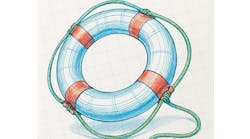This article was printed in CONTROL's November 2009 edition.
Greg McMillan and Stan Weiner bring their wits and more than 66 years of process control experience to bear on your questions, comments, and problems. Write to them at [email protected].
Stan: The best way to keep your job, save our profession, and do wonderful things is to quantify the benefits of process control improvements. Money talks. Operations and management may not understand control jibber jabber, but they will buy into a technology that saves their jobs and their plants. Skeptics can rapidly become advocates given the right dollars.
Greg: As the man in the movie said, "Show me the money!" More than ever, if you want to do neat things in process control, you need to show monetarily decisive benefits.
Stan: Automation engineers are generally not salespeople, so they need to have the numbers do the talking.
Greg: The best way for process control to get credit for improvement in plant operation is for the process metric to be in the data historian. A visible change in capacity, efficiency or quality after a change in the process control system provides the numbers needed to keep the system in service, and enable expenditures and new opportunities.
Stan: We are fortunate to have Michel Ruel, president of Top Control, to provide us with examples of process contol improvement (PCI) that have a big impact on plant performance.
Greg: The first case shows how PCI can eliminate quality problems that cause downtime and a significant loss in revenue.
Michel: In the first case, a paper mill had too many sheet breaks. Everything pointed to pulp quality as the culprit. For months, the plant reviewed its operating procedures, but the number of sheet breaks remained the same. In the project kickoff meeting, the process control engineer explained that the role of the DCS is not just to display values, but to control and automate the process as much as possible. We decided to reduce operater-generated variability and to design control strategies to reach goals. We would push the process and the equipment and limit production rate by constraint control when quality started to deviate from limits. We put loops back into auto and cascade, returned around 20 loops, and added new control strategies. We developed control strategies to mimic what operators were doing to maintain quality. During the first night, the best-ever quality was recorded with the same production rate. In the wrap-up meeting, we instructed the plant to let the system work, not permit operators to try "their" solutions, not play DCS and wait two weeks before deciding if the project was a success or not. The result was the number of sheet breaks per day was reduced from 11.6 to 5.6, which translated to an increase in capacity worth $48,000 per day. The project took one week and cost $12,000. The plant decided the DCS was an interesting tool after all! In three other units, automation was increased, and loops were put in Auto (Probably the simplest KPI in a plant should be how you use your systems, and number of loops in the appropriate mode is probably the simplest one). The plant bought an optimization tool and a performance supervision program. Engineers and technicians were trained and results were sustained by closely monitoring loop usage (% of loops, in right mode and not saturated and in use), stability (oscillation, stiction and settling time)and performance (variability).
Stan: The second case shows how the PCI can save significant fuel costs for boilers.
Michel: The cost of steam production was too high ($33 million per year). In the project kickoff meeting, the process control engineer explained that the steps were to develop fuel management strategies, boiler management strategies, optimize each boiler, minimize the number of boilers used, and employ intelligent load sharing. We developed fuel management strategies in the DCS to handle fuel selection and, at the same time, handle production changes. We developed boiler-selection strategies. Feed-forward was added for each consumer in the plant. We removed previous strategies to handle special cases (over 25 years of ad hoc automation) to let the system work. We optimized each boiler. Strategies were reviewed, automation (start-up, shutting down, emergency sequences) was modified, the burner management system was verified and modified, loops were retuned, and instruments were calibrated.
The biomass boiler required special attention. It uses a lot of automation that had to be optimized. Awareness of problems at feeding section was key, and we added special alarms to inform operators of mechanical problems. In this wrap-up meeting, we once again instructed the plant to let the system work, not let operators try "their" solutions, not play DCS, and wait four weeks before deciding if the project was successful. Wait for the numbers! Also, the plant could stop the idling gas boiler to reduce cost and eliminate corrosion in the stack that occurs at low loads. This was now possible because when a boiler has to be stopped, the system has 20 minutes of buffer in the steam distribution headers, and the gas boiler could now be restarted in less than half the time. The result was fuel savings of $3 million per year. The project took nine weeks and cost $225,000. The plant bought an optimization tool, a performance supervision program, and alarm management software. Engineers and technicians were trained. Alarm management was used to not only reduce alarms and improve their quality, but also to detect where the operators were "playing DCS." The alarm management system reduced alarms by 35% and operator interventions by 43%.
Greg: The third case shows how improvements in tuning, valves and strategies can provide a dramatic improvement in product quality.
Michel: Product density had excessive variability that frequently exceeded the limit. In the kickoff meeting, the process control engineer explained that the steps were to define goals, constraints from the process and operation problems. Using control performance monitoring (CPM) software where two years of monitoring data was available, we determined that 20 loops needed attention. CPM found three problematic control valves that were repaired by plant personnel. Many control strategies were developed after interviewing operators. These control strategies addressed requests regarding equipment limits and flaws and operation procedures. The main idea was that some periods where performance was acceptable were followed by low quality periods, so we identified operation and equipment limits. Using valve travel and time at the limit, we determined that fouling could be predicted. Operator support was gained by working closely with them, and extending the project by one week to insure that all would be trained. Once more, in the wrap-up meeting, the plant was told to let the system work, not let operators to try "their" solutions, not play DCS, and wait four weeks before deciding if the project was a success or not. (Sound familiar?) The result was a reduction in density variability from 0.212 to 0.06 and a reduction in time the density exceeded limit from 17% to 2%. The project cost $36,000 and took three weeks. The plant bought an optimization tool and trained its engineers and technicians. The plant already had CPM, and after seeing what we could extract from this system, they asked to be coached on how to use it better.
Stan: We're also lucky to have a managing editor, Nancy Bartels, with a good sense of humor.
Nancy: Your October Top 10 list made me smile. I love the reality show idea. Think about it. "Automation Idol." Start with 15 aspiring control engineers. Each week one of them is eliminated from the challenge. You and Stan could be the judges and say nasty things that make the contestants cry. They could also have snippy fights and try to sabotage and blame each other when something goes wrong. You need at least one contestant with body piercings and one or two with lots of tattoos, and a couple of cute girls. This could be cool. I'd watch.
Greg: From Austin, listening to the "Cowboy Song" by Thin Lizzy, "McMillan out!"







